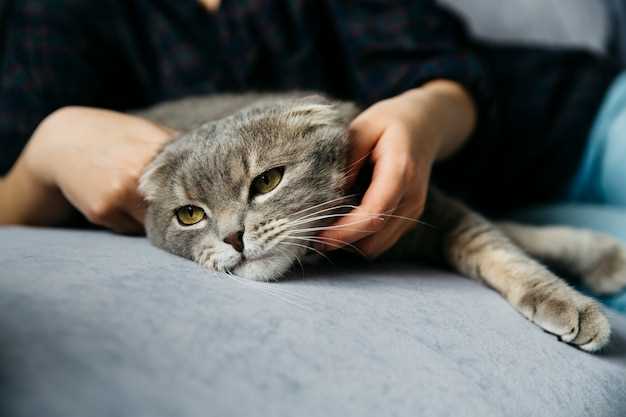
Mirtazapine is a commonly prescribed medication for cats to stimulate their appetite and manage vomiting. However, like all medications, it can have potential side effects that pet owners should be aware of.
If you’re noticing any unusual behavior or symptoms in your feline friend after starting mirtazapine, it’s crucial to consult your veterinarian immediately. Keep your cat’s health a top priority and stay informed about the side effects of mirtazapine.
Overview of mirtazapine
Mirtazapine is a medication that belongs to a class of drugs known as tetracyclic antidepressants. It is commonly prescribed for cats to stimulate their appetite and manage behavioral issues.
This medication works by increasing the levels of certain neurotransmitters in the brain, such as serotonin and norepinephrine, which play a role in regulating mood, appetite, and behavior. By enhancing the function of these neurotransmitters, mirtazapine can help improve appetite and reduce anxiety in cats.
In addition to its antidepressant properties, mirtazapine also has antiemetic effects, making it useful for cats that suffer from nausea or vomiting. It can help stimulate the appetite in cats that are not eating well due to various medical conditions or stress.
It is important to follow the prescribed dosage and administration instructions carefully to ensure the safety and effectiveness of mirtazapine in cats. Your veterinarian will determine the appropriate dose based on your cat’s condition and response to the medication.
Mechanism of action
Mirtazapine works by increasing the levels of certain neurotransmitters in the brain, namely serotonin and norepinephrine. It is a noradrenergic and specific serotonergic antidepressant (NaSSA) that acts as an antagonist at the alpha-2 adrenergic pre-synaptic receptors and as a potent antagonist at the 5-HT2 and 5-HT3 receptors.
By blocking the alpha-2 adrenergic receptors, mirtazapine enhances the release of both serotonin and norepinephrine, which can lead to an increase in appetite and food intake. This makes mirtazapine especially useful in cats with a decreased appetite due to various medical conditions or behavioral issues.
The 5-HT2 and 5-HT3 receptor antagonism of mirtazapine also contributes to its antiemetic properties, making it effective in managing nausea and vomiting in cats. Overall, the unique mechanism of action of mirtazapine makes it a versatile medication for a variety of health concerns in feline patients.
Common uses in cats
Mirtazapine is commonly prescribed for cats to help stimulate their appetite and combat nausea. It is often used in feline patients who have a decreased appetite due to various health conditions such as renal disease, liver disease, cancer, or other illnesses. Mirtazapine works by affecting serotonin and other neurotransmitters in the brain, which can help improve appetite and reduce nausea in cats.
Side effects of mirtazapine
Mirtazapine can have various side effects in cats, and it is important for pet owners to be aware of these potential issues. Some of the common side effects include:
Gastrointestinal Problems
One of the most common side effects of mirtazapine in cats is gastrointestinal issues. This can include vomiting, diarrhea, and lack of appetite. If your cat experiences any of these symptoms, it is essential to consult with your veterinarian.
Behavioral Changes

Another possible side effect of mirtazapine is behavioral changes in cats. This can include increased aggression, lethargy, or changes in activity levels. Monitoring your cat’s behavior closely while on mirtazapine can help identify any concerning changes.
It is crucial to discuss the potential side effects of mirtazapine with your veterinarian before starting treatment to ensure that you are aware of what to expect and how to manage any issues that may arise.
Gastrointestinal issues
Many cats may experience gastrointestinal issues as a side effect of mirtazapine. These issues can include vomiting, diarrhea, constipation, and appetite changes. It’s important to monitor your cat closely for any signs of gastrointestinal distress while on mirtazapine.
If your cat is experiencing gastrointestinal problems, consult your veterinarian for advice on how to manage these symptoms. In some cases, adjusting the dosage or frequency of mirtazapine administration may help alleviate these issues.
Ensure that your cat has access to fresh water at all times and consider feeding smaller, more frequent meals to help regulate their digestion. If the gastrointestinal issues persist or worsen, contact your veterinarian immediately for further guidance.
Behavioral changes

Mirtazapine can sometimes cause behavioral changes in cats. These changes may include increased activity, restlessness, or agitation. Some cats may also exhibit unusual behaviors such as vocalization or aggression. If you notice any significant changes in your cat’s behavior while they are taking mirtazapine, it is important to consult your veterinarian immediately.
It is essential to monitor your cat closely while they are on mirtazapine to ensure that they are not experiencing any negative behavioral side effects. If any concerning behaviors arise, your vet may recommend adjusting the dosage or discontinuing the medication altogether.
Managing side effects
It is important to closely monitor your cat for any signs of side effects while they are on mirtazapine. If you notice any gastrointestinal issues such as vomiting or diarrhea, consult your veterinarian immediately. They may recommend adjusting the dosage or trying a different medication.
Behavioral changes can also occur in some cats on mirtazapine. If you notice any unusual behaviors, such as increased aggression or lethargy, contact your vet for guidance.
Managing side effects involves proper communication with your veterinarian and following their recommendations. Remember to never adjust the dosage or stop the medication without consulting your vet first.
Adjusting dosage
It is crucial to follow the veterinarian’s prescribed dosage of mirtazapine for your cat. Depending on the cat’s response and side effects, the dosage may need to be adjusted. Increasing or decreasing the dosage without consulting the vet can have adverse effects on your cat’s health.
Before adjusting the dosage, it is important to observe your cat’s behavior and any changes in symptoms. If you notice any concerning signs or if the current dosage is not providing the desired results, contact your veterinarian immediately to discuss possible dosage adjustments.
Guidelines for adjusting dosage:
| 1. Increase in side effects: | If your cat experiences severe side effects such as excessive sedation or gastrointestinal issues, the vet may recommend decreasing the dosage. |
| 2. Inadequate response: | If the current dosage is not effective in managing the symptoms for which mirtazapine was prescribed, the vet may suggest increasing the dosage after evaluation. |
| 3. Gradual changes: | Any adjustments to the dosage should be done gradually under the supervision of a veterinarian to minimize the risk of adverse reactions. |
